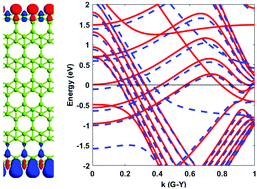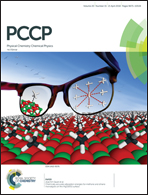Freestanding χ3-borophene nanoribbons: a density functional theory investigation†
Abstract
Experimental observation of borophene nanoribbons (BNRs) motivated us to carry out a comprehensive investigation on BNRs, decomposed from a χ3 sheet, using density functional theory. Our results show that the stability and also the electrical and magnetic properties of the ribbons are strongly dependent on the edge configurations. We have studied two categories of ribbon: XBNRs and YBNRs. The first one is a nonmagnetic metal with armchair shaped edges, while YBNRs can be magnetic or nonmagnetic depending on the edge shape. YBNRs have four different edge types and we show that two of them are magnetic (a- and b-type edges) while the other two are nonmagnetic (c- and d-type edges). There are 10 distinct configurations possible by arranging the different edges of YBNRs. 10 percent of YBNRs are polarized asymmetrically at the edges, leading to the loss of degeneracy of the spin-up and spin-down bands in the antiferromagnetic configuration. 40 percent of YBNRs have one magnetic edge and can be promising candidates for spintronic applications due to the separation of the spin in the real space in addition to the energy space. Electronic transmission properties of the ribbons were also studied and we found that transmission channels are suppressed at the edges of XBNRs due to electron localization.



 Please wait while we load your content...
Please wait while we load your content...